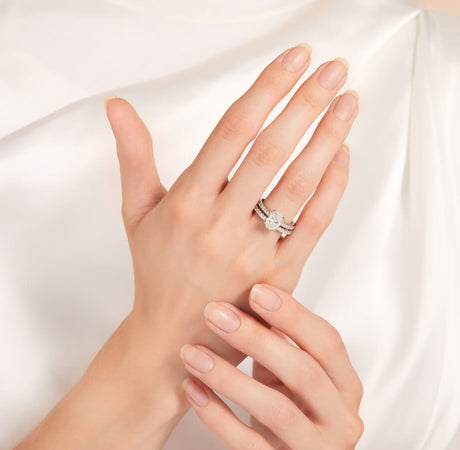Our Gemstones
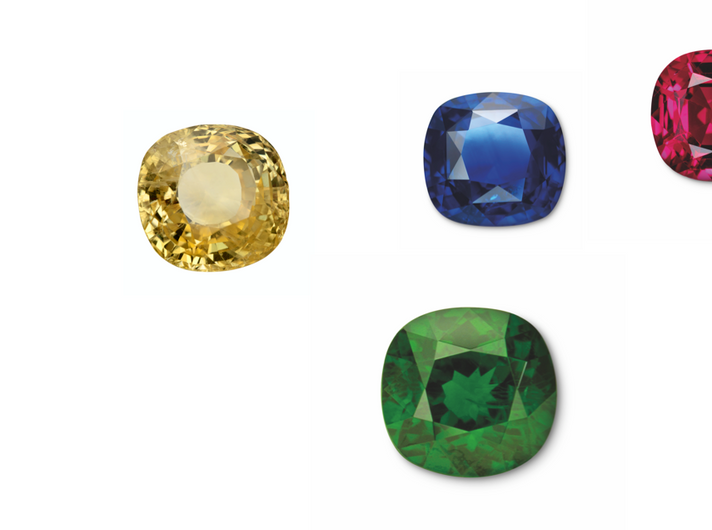
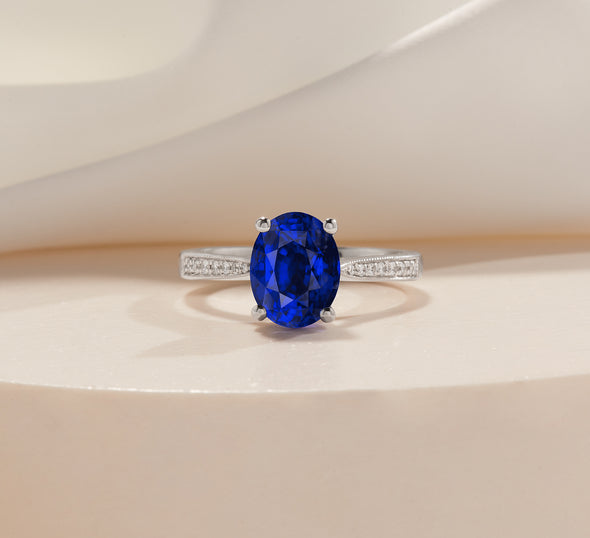
Sapphires
Sapphires are the most popular coloured gemstone for engagement rings. Alongside the intense lustre and depth of colour, the structure of sapphires make them a great choice for an engagement ring that is equal parts alluring and enduring. Reaching 9 on the Mohs scale of hardness, the gemstone is second only to diamonds in durability, its resistance to chipping and scratching making it suitable for everyday wear. Learn more about sapphires, why the gemstone is suitable for engagement rings, and sapphire engagement ring design inspiration.
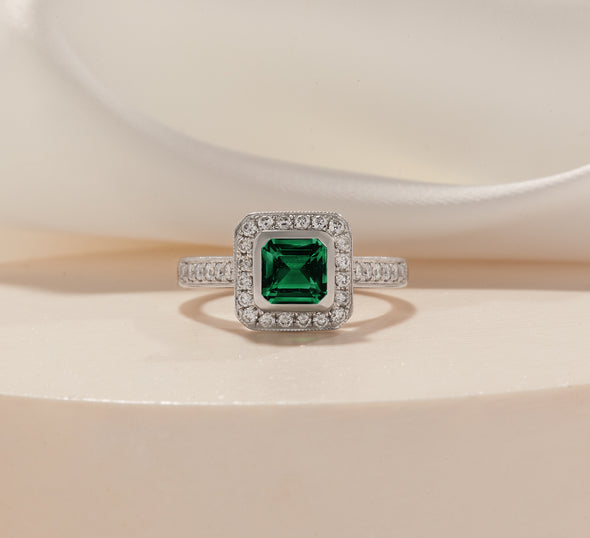
Emeralds
Emeralds are distinct, verdant green gemstones, and are a more unusual choice for gemstone engagement rings. Emeralds are a little softer than sapphires and rubies, ranking 7.5-8 on the Mohs scale, yet their lush and exotic appeal give them a notable charm, ideal for a unique engagement ring. Explore emerald engagement rings designs we love, learn more about the origins of the gemstone and discover how to choose the most ideal emerald for your engagement ring.
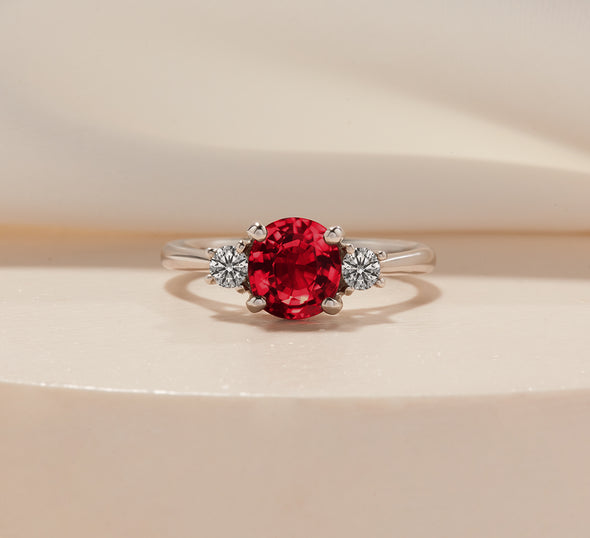
Rubies
Ruby gemstones are a variation of sapphire, and are equally a suitable choice for a wearable, durable and charming engagement ring. With a long history of representing enduring love and passion, the intense crimson tones of the gemstone are the perfect gesture for a meaningful engagement ring. Discover ruby engagement ring styles, how to choose the perfect ruby and whether the gemstone is the right choice for you.
Choosing a gemstone for your engagement ring
Diamonds are undoubtedly the most traditional choice for engagement rings, yet with increasing interest from those in search of more unique and personal designs, precious gemstones are becoming a firm favourite amongst engagement ring buyers. Gemstones offer the chance to inject bold, strong or subtle and elegant colours into your design.
When it comes to selecting gemstones such as sapphires, rubies and emeralds, colour is an important factor to consider. Emeralds are inherently green and rubies red, yet sapphires can be found in a whole spectrum of colours, as well as the most widely recognised cornflower blue.
Typically, gemstones are more favourable and valuable the more vivid the colour, so when looking at blue, red and green gemstones, our experts advise opting for strong tones that are consistent throughout the spread of the stone. Despite this, many have a preference for more subtly toned gemstones, such as soft peach and pink sapphires and pale purples. Connect with one of our experts to learn more.
Learn more about our favourite gemstones
Gemstone A-Z
Amethyst
Mohs Scale of Hardness 7
Reddish purple to violet purple
A variety of quartz, amethyst is a purple gemstone recognised as the birthstone of February. Amethysts’ clarity is typically exceptional, but the gemstone usually features colour zoning - meaning zones within the gemstone can appear colourless or weak in colour. The gemstone is durable enough for fine jewellery, although not ideal for an engagement ring that is likely to be worn everyday.
Aquamarine
Mohs Scale of Hardness 7.5-8
Light, bright blue
Aquamarines are a light, bright gemstone and are typically a less deep hue of blue than sapphires. Deriving from the Latin for ‘water of the sea’, the name ‘aquamarine’ is evocative of the gemstone’s similarity to the crystal-like, vitreous lustre and blue hue of tropical seas. Whilst often overlooked for engagement rings, the hardness of the stone is similar to that of emeralds, making them a suitable choice for a unique engagement ring.
Citrine
Mohs Scale of Hardness 7
Yellow, orangey yellow and brownish yellow
Found in tones that range from rich, warm hues to pale yellow, citrine is a yellow variety of quartz. The vivid colours of citrine are tawny, earthy, and often autumnal, offering warmth to the wearer. Whilst too soft for an engagement ring, the affordable gemstone citrine can be found in large sizes, up to 20ct, making them a great choice for cocktail rings.
Diamond
Mohs Scale of Hardness 10
Colourless, or fancy colours including yellow, brown, pink, red, blue and black
Diamonds are the most suitable gemstone for engagement rings - rare, with unequivocal lustre and the most durable gemstones on the planet. Whilst most opt for a colourless diamond for their engagement ring, the gemstones can be naturally found in a plethora of tones thanks to the presence of elements other than carbon. Learn more about diamonds in our definitive guide.
Emerald
Mohs Scale of Hardness 7.5-8
Green
The use of emeralds in fine jewellery spans civilisations across the globe and throughout time. The colour of emeralds ranges from yellow-greens to blue-greens - the most admired emeralds (the purest green) are found in Colombia, the most ideal colour thus named ‘Colombian green’. Softer than diamonds, rubies and sapphires, emeralds aren’t a common choice for engagement rings, but are determined hard enough for daily wear. Learn more about emerald engagement rings.
Garnet
Mohs Scale of Hardness 6.5-7.5
Red, brownish red, orange, yellow and green
Garnets are most commonly red, the green varieties carrying a much steeper price tag due to their rarity. Garnets are otherwise an affordable gemstone, and are often used in jewellery as an alternative to pricier rubies. However, due to their softness, garnets are not suitable for engagement rings, and are prone to scuffing and chipping.
Moonstone
Mohs Scale of Hardness 6-6.5
White / transparent, peach, green, brown and grey
Moonstones are an enchanting gemstone, the transparent stones famed for their strong blue sheen. The sheen is caused by the internal structure of the gemstone, which causes light to scatter - this is called adularescence. The beauty of gemstones makes them suitable for semi-precious jewellery, but due to the softness they are not ideal for engagement rings.
Morganite
Mohs Scale of Hardness 7.5
Pink
Named after American banker and gem enthusiast J. P. Morgan, morganites are a pale pink gemstone, ranging from pure pink to orange, salmon tones. Morganites are a little softer than ideal for engagement rings, but many adore the romantic pink hues of the stone. A more suitable alternative would be a pink or peach sapphire, which can be found in similar hues to morganites.
Opal
Mohs Scale of Hardness 5.5-6.5
Multicoloured
A phenomenal stone displaying an unparalleled play-of-colour; a rainbow-coloured kaleidoscopic effect. The main categories of opal are black, white, water, boulder and fire opal. Black opals are the most valuable and they have a dark black, grey, blue, green or brown background that makes the play-of-colour flashes stand out the most. Opals are not durable enough to stand up to the everyday wear of an engagement ring, but they are ideal in pendants and earrings.
Peridot
Mohs Scale of Hardness 6.5-7
Olive green
Peridot is the gem variety of the mineral olivine. Peridots’ colour range is very limited; they only come in light to dark yellowish greens which are caused by the presence of iron. Peridots are relatively clean stones but they occasionally have a typical disk-like liquid and gas inclusion known as “lily-pad”. Peridot is suitable only for jewellery that has secure settings to protect the stone from wear.
Ruby
Mohs Scale of Hardness 9
Red
The more intense the red hue of a ruby, the most valuable it is, yet the gemstones can range from pinkish reds to orangey reds and purplish reds. The ideal, vivid red is named ‘pigeon blood’ or ‘blood red’ - which is a pure, vibrant tone. Rubies are a variant of sapphires, and are an ideal choice for an engagement ring due to the passionate colour, lustre and durable structure of the gemstone. Learn more about ruby engagement rings.
Sapphire
Mohs Scale of Hardness 9
Blue, purple, pink, peach, green, yellow, and most desired colours
A sapphire engagement ring typically features a blue version of the gemstone, but the versatile sapphire can be found in a whole spectrum of colours and tones. Deep, vivid blue sapphires are the most popular choice, whilst Padparadscha, a peachy-pink colour, is recognised as the most valuable of sapphire colours. The lustre, clarity and durable structure of sapphires makes them one of the most suitable gemstones for engagement rings. Learn more about sapphire engagement rings.
Spinel
Mohs Scale of Hardness 8
Red, pink, orange, purple, violet, blue
Similarly to sapphires, spinel gemstones can be found in a wide variety of colours. In the past, spinel was often confused with sapphire, and to this day can be a great (and more affordable) alternative to sapphires for engagement rings. Whilst the gemstone has great lustre and durability, the colour of spinel can be less vivid than that of sapphires - for example, blue spinel can appear a little grey in colour.
Tanzanite
Mohs Scale of Hardness 6-7
Purplish blue
Whilst tanzanites may appear similar to blue sapphires, the tone is typically less desirable, with notes of purple, violet tones. Most tanzanites are treated, altering their natural colours to eliminate the presence of yellow or brown tones. The gemstones are lustrous, but too soft for engagement rings. With a lower price point than sapphires, tanzanites a good alternative for a blue gemstone cocktail ring, but aren’t ideal for everyday wear.
Topaz
Mohs Scale of Hardness 8
Light to deep blue, golden yellow, orange, brown, bright pink, red, purple, green or colourless
Topaz can occur in a wide range of colours, the most common being blue and golden yellow. Usually, it has very few inclusions and looks clean to the naked eye. Topaz's hardness makes it suitable for all types of jewellery.
Tourmaline
Mohs Scale of Hardness 7-7.5
Pink, green, blue, orange, yellow, brown, black, and colourless
Tourmaline’s name derives from the Sinhalese word 'toromalli' which means 'mixed gems' as they are found in such a wide range of colours. Bi-coloured Tourmalines are also common and stones which are coloured pink to green are known as watermelon tourmaline. Tourmaline is suitable for most types of jewellery and is cut into faceted stones, cabochons as well as beads and carvings.
Zircon
Mohs Scale of Hardness 6.5-7.5
Blue, colourless, red, yellow, orange, brown and green
Zircon has a bright lustre and high, diamond like dispersion. It is very brittle, so the facet edges can easily chip and abrade. For this reason Zircons are better suited to earrings and pendants, where the stone will not get knocked.
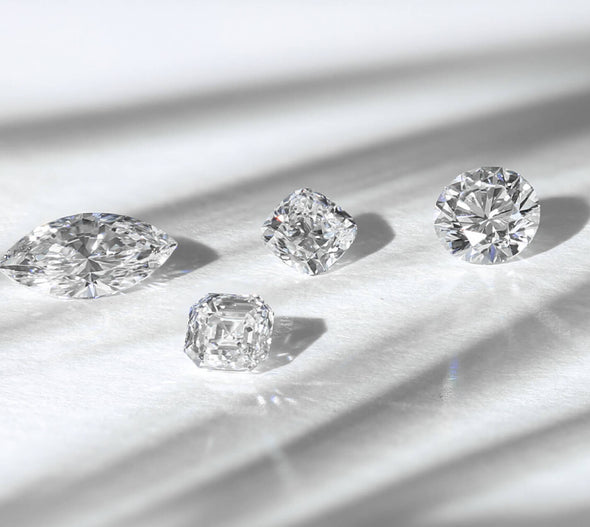
Next Step
We’re based in the heart of Hatton Garden
Start your journey today by booking an in-store or virtual appointment with one of our friendly, knowledgeable design consultants.
